
|
xTuple ERP Reference Guide |
To create a new purchase order, go to . The following screen will appear:

When entering a new purchase order, you are presented with the following options:
Next available purchase order number will automatically display, unless your system requires you to enter purchase order numbers manually. Default values and input parameters for purchase order numbers are configurable at the system level.
Displays current day's date.
Displays the date the purchase order was released.
Enter the vendor number of the vendor you are issuing the purchase order to.
A valid vendor number must be entered in the Vendor # field before line items can be added to the purchase order. If no valid vendor number is entered, you will not be able to add line items to the purchase order.
Specify the billing terms for the order. Default billing terms for a vendor are defined on the Vendor master. You may select alternate terms on the purchase order header.
Specify the tax zone associated with the purchase order. By default, the tax zone associated with the vendor will be used.
The status of the purchase order will display here.
Specify the name of the agent assigned to the order. By default, the name of the logged-in user will be entered as purchasing agent—assuming that user is designated as a purchasing agent. If the user is not a purchasing agent, the first alphabetical name in the list of purchasing agents will be entered.
Check Print on Save to automatically print the purchase order when the button is pressed. If the vendor specified on the purchase order has an EDI profile attached, you may encounter an EDI processing interface when printing the purchase order.
Displays information about linked sales orders. This field is only used if the purchase order was created from a sales order.
Specify a purchase type for reporting purposes.
Specify the vendor address information:
Displays the vendor's main address. You may manually override the displayed address information in the fields below—or use the lookup feature to select another address. If a new address is manually entered here, that address will be added automatically to the master list of addresses. For additional documentation related to creating addresses, see Section 8.1, “ New Address”.
Displays the vendor's primary contact. You may manually override the displayed contact information in the fields below—or use the lookup feature to select another contact. If a new contact is manually entered here, that contact will be added automatically to the master list of contacts. For additional documentation related to creating addresses, see Section 7.1, “New Contact”.
Specify the ship-to address information:
Specify the site where materials from the purchase order will be received. By default, all active sites are available for selection as receiving sites.
If the purchase order was created as a drop ship order from a sales order, this option will be selected. This option is only available for drop ship purchase orders linked to sales orders.
The name that is associated with the ship-to address. A purchase order created from a drop ship sales order item will have the ship-to address name displayed in this field.
Displays either the site address for the specified receiving site or, for drop ship orders, the customer ship-to address from the linked sales order. You may manually override the displayed address information in the fields below—or use the lookup feature to select another address. If a new address is manually entered here, that address will be added automatically to the master list of addresses. For additional documentation related to creating addresses, see Section 7.1, “New Contact”.
Displays either the contact information for the specified receiving site or, for drop ship orders, the contact for the customer ship-to address on the linked sales order. You may manually override the displayed contact information in the fields below—or use the lookup feature to select another contact. If a new contact is manually entered here, that contact will be added automatically to the master list of contacts. For additional documentation related to creating addresses, see Section 7.1, “New Contact”.
Enter the free on board (F.O.B.) location for the shipping site.
Enter the preferred ship via method for this vendor. By default, the ship via entered on the Vendor master will populate this field.
To create or modify purchase order line items, select the tab at the top of the Purchase Order screen. The following screen will appear:

When creating or modifying purchase order line items, you are presented with the following options:
Display lists line items for this purchase order. A valid vendor number must be entered in the Vendor # field before line items can be added to the order.
Displays the total of all line item quantities on the order.
Displays the total weight for all line item quantities on the order.
Displays the subtotal for the purchase order line items.
Enter the amount of any miscellaneous freight charges to be added to the order.
Displays the total amount of freight charges. The amount displayed includes the sum of all line item freight and miscellaneous freight charges.
Displays the calculated tax amount, if applicable. Purchase tax is calculated at the purchase order line item level. The tax amount displayed here represents the total for all line item tax amounts. It will also include tax on freight, if a matching freight tax type assignment is found. To get a detailed view of the tax calculation, click on the link using your mouse.
Displays the total value of the purchase order.
The following buttons are unique to this screen:
Highlight a purchase order line item and then select this button to move the line item up the list of line items. Sequence numbers are automatically adjusted to reflect the change in position.
Highlight a purchase order line item and then select this button to move the line item down the list of line items. Sequence numbers are automatically adjusted to reflect the change in position.
Purchase order characteristics are user-defined definitions which may be used to provide additional layers of description about purchase orders. These descriptions are static and not processed by the system, but are useful for informational purposes. To enter characteristics associated with a purchase order, select the tab. The following screen will appear:
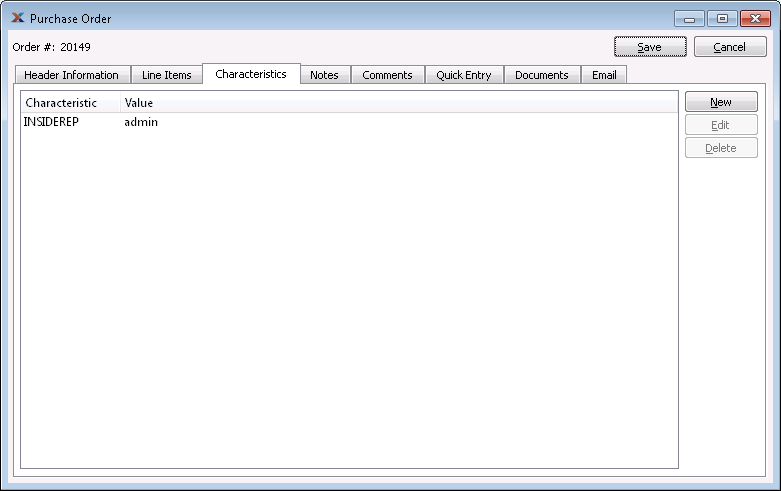
Purchase Order Characteristics
To create a new characteristic for your current context, select the button from the characteristics list. The following screen will appear:

When creating a new characteristic, you are presented with the following options:
Select a characteristic from the list of characteristics available for your current context. To learn more about how characteristics are linked to specific contexts, please see Section 9.2.2.1, “Characteristic”.
Enter a value to associate with the characteristic.
In some contexts, the Default option will appear. Select if the value entered is the default value for the specified characteristic. Default values will always be listed first where characteristics are used.
To add notes to a purchase order, select the tab at the top of the Purchase Order screen. The following screen will appear:

When adding notes to a purchase order, you are presented with the following options:
This is a scrolling text field with word-wrapping for entering notes related to the purchase order. If the vendor has order notes associated with their vendor record, those order notes will be displayed here.
To add comments to a purchase order—or to view system-generated comments—select the tab at the top of the Purchase Order screen. The following screen will appear:
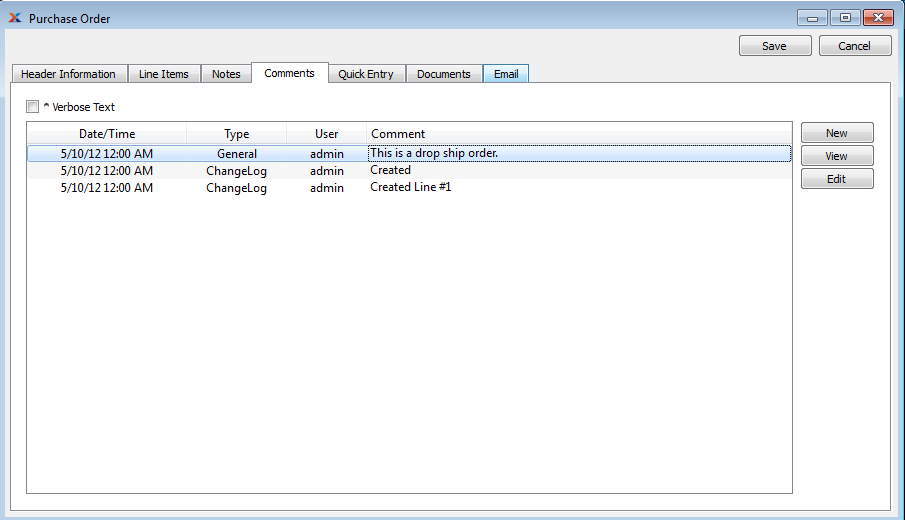
When adding or reviewing comments, you are presented with the following options:
Select to display all comments in the list in an expanded view which includes the entire text of each comment. To edit a comment, simply select the link next to the comment. That link will not be shown for changelog comments, which can't be edited. If the Verbose Text option is not selected, the comment list will display only header level information for each comment.
Display lists comments related to the record.
The following buttons are available:
Opens screen for creating a new comment.
Highlight a comment and then select this button to reach a read-only view of the Edit screen.
Enables you to edit highlighted comments—as long as the comments are not changelog comments. ChangeLog comments are system-generated and may not be edited. The Edit screen is the same as that for creating a new comment—except that when editing, the fields will contain comment information. Double-clicking on a comment will also bring you to the editing screen.
To enter a new comment, select the button. The following screen will appear:

Select a comment type from the drop-down list to classify the comment. This is a required step. Comment types may be system-defined (i.e., changelog and general) or user-defined, as described in Section 13.2.3, “Comment Types”. Once you have specified a comment type, begin typing your comment in the main text area. The text area features word-wrapping and scroll-bar support for longer comments.
The following buttons are unique to this screen:
Select to show the complete list (i.e., thread) of comments associated with the record. To hide the list, simply select the button again. The comment thread will show the most recent comment first.
If you want to speed up your data entry of purchase order line items, you can use the quick entry interface. This screen allows you to enter multiple line items in one session. It also simplifies the process by presenting only the minimum required fields. To enter line items using the quick entry interface, select the tab at the top of the Purchase Order screen. The following screen will appear:
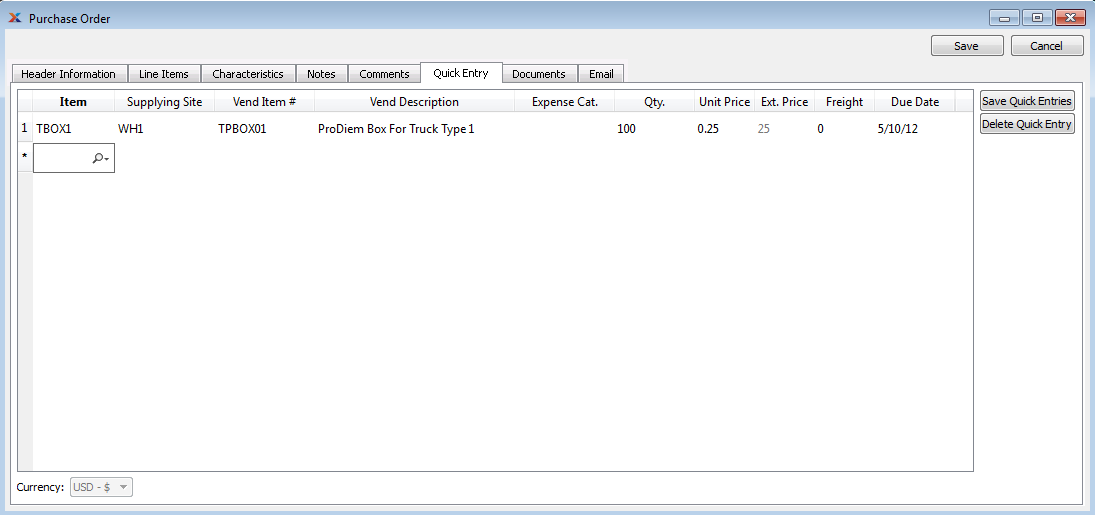
To get started entering line items, place your cursor in the Item field. You can then move from field-to-field using the key on your keyboard.
When entering purchase order line items using the quick entry interface, you are presented with the following options:
Enter an inventory item number. This field is used for entering items stored in inventory. Use the Vend. Item # field for entering non-inventory items.
Select a supplying site from the list of available options. By default, the user's preferred site will be presented first.
Use this field for entering non-inventory item numbers. If not used to handle non-inventory items, this field will display vendor item numbers for inventory items which have item sources defined.
Enter the vendor description for the item being ordered.
Enter the expense category you want your non-inventory quantity to be assigned to. Use this option for non-inventory line items only.
Enter the quantity you want to purchase.
Enter the unit price for the line item. If an item source is defined, this information may fill in automatically.
Displays the extended price. This is a calculated field and is shaded to indicate that it may not be edited.
Enter the freight amount, if any.
Enter the due date. If an item source is defined, this information may fill in automatically. For drop ship orders, the due date for purchase order items will be the same as the linked sales order's scheduled date.
The following buttons are unique to this screen:
Select to save all the line items entered using the quick entry interface.
Highlight a line item and then select this button to remove the item from the list.
To view the documents associated with a purchase order, select the tab. The following screen will appear:
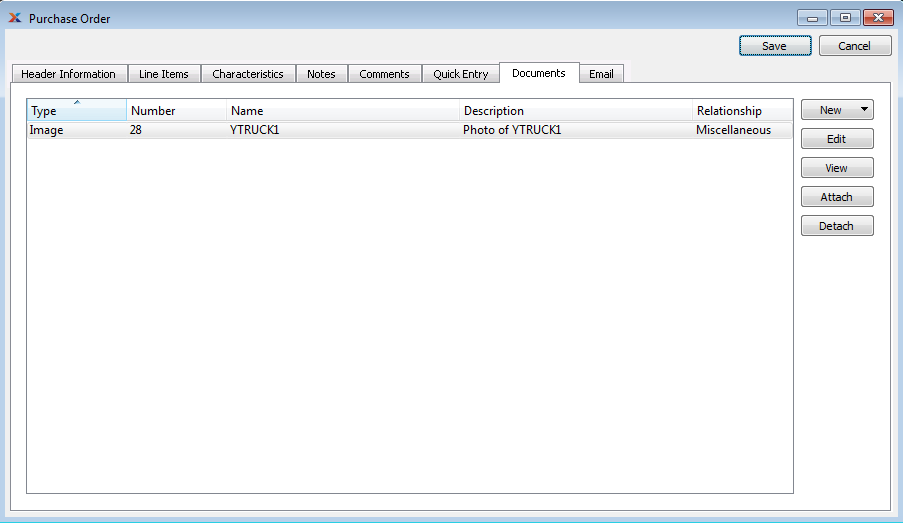
Purchase Order Documents
When associating documents, you are presented with the following options:
Select to create a new document and associate it with the current record. You may create the following document types:
Select to create a new image association.
Select to create a new fixed asset association.
Select to create a new maintenance order association.
Select to create a new incident and associate it.
Select to create a new project and associate it.
Select to create a new opportunity and associate it.
Select to create a new to-do and associate it.
Enables you to edit associated documents. The Edit screen is the same as that for creating a new document—except that when editing, the fields will contain document information. Double-clicking on a document will also bring you to the editing screen.
Highlight a document and then select this button to reach a read-only view of the Edit screen.
Select to associate already-existing documents. The following document types may be attached: contact, account, customer, employee, file, image, incident, item, opportunity, project, purchase order, sales order, vendor, web site, work order.
Highlight a document and then select this button to remove the association.
To associate already-existing documents, select the button. The following screen will appear:
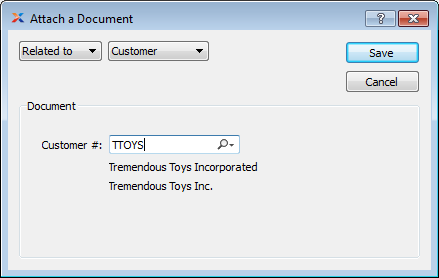
When associating already-existing documents, you are presented with the following options:
Indicate how the document is related to the current record. The following relationship options are available: related to, parent of, child of, duplicate of.
Specify the kind of document you want to associate. The following document types may be attached: contact, account, customer, employee, file, image, incident, item, opportunity, project, purchase order, sales order, vendor, web site, work order. When associating files, you will also be given the option to save the file to the database.
There is no file size restriction when saving files to the database. However, excessively large files could cause storage and performance issues.
Use the lookup tool to identify the specific document you want to attach. The data entry options will vary depending on the document type you select.
To view email associated with a purchase order, select the tab. The following screen will appear:

When viewing associated emails, you are presented with the following options:
Display lists associated emails.
The content of a highlighted email will be displayed here.
Specify the maximum number of associated emails you want to be displayed in the email list. If the list is extremely long, you may experience some slowness when opening the screen.
Select to load all associated emails into the list.
Enter a string of letters or complete words to search for matches in the list of associated emails. The search will scan through subject lines, To addresses, and From addresses.
The following buttons are unique to this screen:
Select to send a new email, using the default email program on your computer.
Highlight an email and then select this button to print a copy of the email.
Highlight an email and then select this button to reply to the email's sender, using the default email program on your computer.
Highlight an email and then select this button to reply to everyone associated with the email, using the default email program on your computer.
Highlight an email and then select this button to forward the email to another person(s), using the default email program on your computer.
Highlight an email and then select this button to attach an email associated with a contact in your contact list.
Highlight an email and then select this button to remove the associated email from the list.